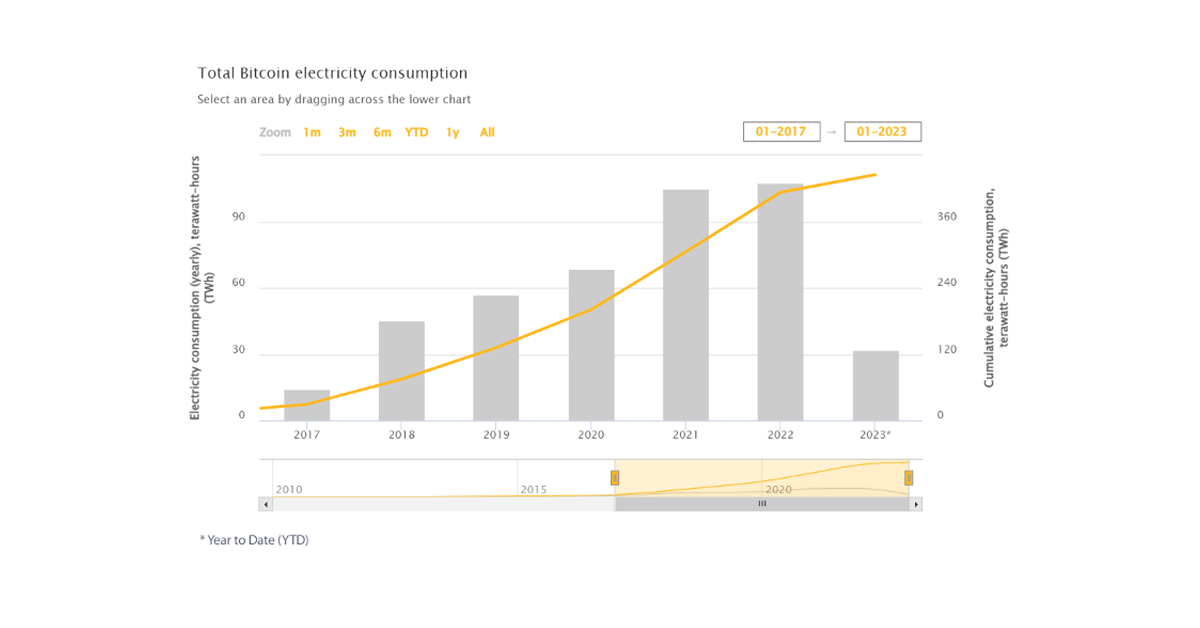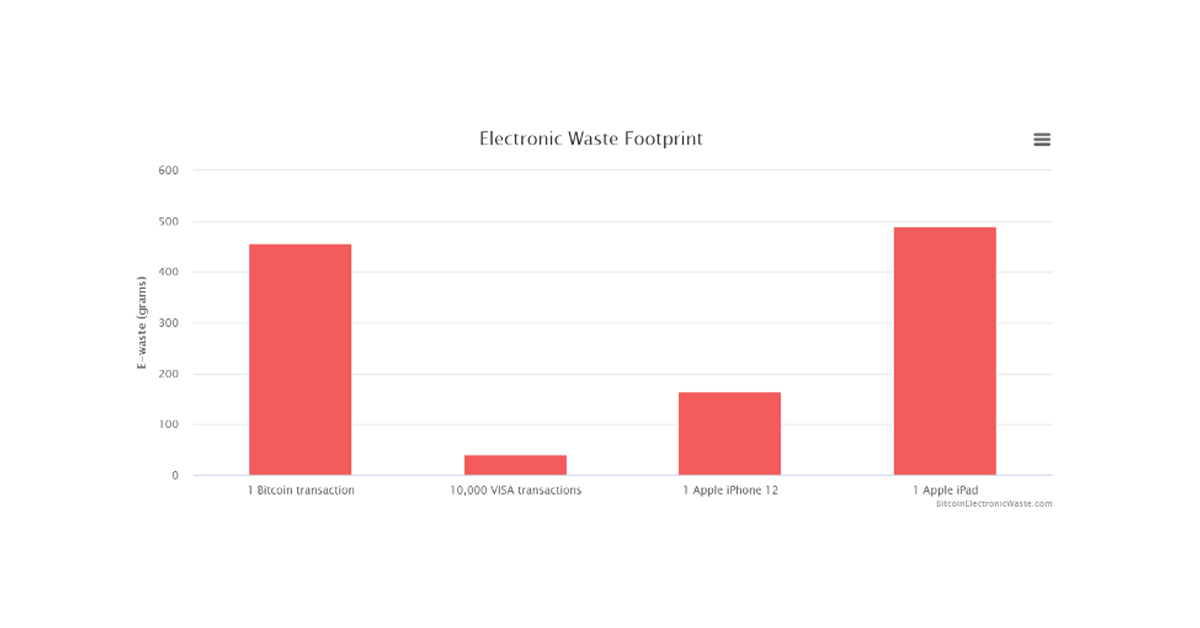
Cryptocurrency has the potential to revolutionize the way we think about money and digital assets. However, in addition to the recent bumps in the road related to theft and fraud, some experts also have concerns about the environmental impact of cryptocurrency mining and transactions.
One major issue is the amount of energy required to support the cryptocurrency ecosystem. According to recent estimates, the total energy consumption of the Bitcoin network alone is equivalent to the energy consumption of a small country. This is due to the complex cryptographic algorithms required to process transactions and validate new blocks of data on the blockchain.

Image: https://ccaf.io/cbeci/index
One way to visualize the volume of electronic waste produced by the Bitcoin network is by comparing the electronic waste generated by a single Bitcoin transaction with the electronic waste associated with a couple of common items and the amount of electronic waste per transaction handled by a financial institution such as VISA.

Image: https://digiconomist.net/bitcoin-electronic-waste-monitor/
The main reason cryptocurrency takes so much energy is related to the algorithms used to validate transactions. The two most common algorithms used in cryptocurrency are Proof of Work (PoW) and Proof of Stake (PoS).
PoW algorithms require miners (people who create new digital “coins”) to compete for cryptocurrency rewards by solving complex mathematical problems to validate transactions. This competition involves a significant amount of computational power and, subsequently, energy consumption.
On the other hand, PoS algorithms require miners to put down a deposit in exchange for the right to “create coins.” Without the need for competition, PoS reportedly uses 99% less energy than PoW. But while PoS is generally considered more environmentally friendly than PoW, it’s not without its own set of challenges — the high cost of entry for miners can be prohibitive and limit decentralization.
Drivers of Sustainability
Two main drivers of sustainability in the Web3 and cryptocurrency industries are external pressure and innovation.
Consumers and "green" organizations are putting pressure on the industry to adopt more sustainable practices, while innovators are increasingly recognizing the importance of sustainability for long-term success. Opportunities include using renewable energy sources, designing more energy-efficient systems, or creating technologies that reduce waste or improve resource usage. This shift in mindset is leading to the development of new technologies and approaches that are more sustainable than traditional cryptocurrency mining and transaction methods —PoS vs. the traditional PoW, for example.
Some cryptocurrency companies are already leading the charge. While Bitcoin has been criticized for its high energy usage, Ethereum, the second-largest cryptocurrency, recently transitioned from PoW to PoS. In September 2021, research indicated that Ethereum had an annual energy consumption of approximately 44.98 TWh, but it has since decreased its electricity usage by 99.84% by changing its production approach.
Sustainability: Efficiencies to Help Offset Consumption
A few approaches can help offset the energy consumption and reduce the carbon footprint associated with cryptocurrency:
Carbon credits and the offset trading market:
Companies can purchase carbon credits to offset their carbon emissions and support sustainability initiatives.
Voluntary carbon market:
Companies can invest in projects that reduce carbon emissions and support sustainable development.
Automation of back-end processes:
Transaction processing and verification, data storage and management, and mining operations can be automated, and energy consumption can be more closely monitored and controlled to reduce usage and improve efficiency.
Facilitate conscious consumerism:
Making product lifecycle information available can help consumers make more informed decisions about their cryptocurrency usage. Understanding the environmental impact of their actions enables consumers to make choices that are more sustainable and have a lower carbon footprint.
Sustainability: Alternate Sources of Energy
Renewable sources of energy — solar, wind, hydropower, geothermal, tidal power, and waste energy —are becoming increasingly popular options for powering cryptocurrency mining operations. These sources are more sustainable and have a lower environmental impact than traditional sources, such as coal or natural gas.
In addition, several major players in the industry, including AWS, Google, Microsoft, and Meta, have made net-zero carbon emission commitments that involve using renewable sources of energy to power data centers and mining operations and reducing carbon emissions through carbon offsets and other initiatives.
And finally, there’s an option for miners to sell excess energy back to the grid, which can help offset the energy consumption of their mining operations.
The Bottom Line
While the mining process is energy-intensive and the demand for computing power is increasing, solutions are available to address the issue. For these solutions to work, the industry needs to prioritize sustainable practices and individuals need to promote environmentally conscious actions in the digital world.
Contact Us
Let's talk!
We're ready to help turn your biggest challenges into your biggest advantages.
Searching for a new career?
View job openings
